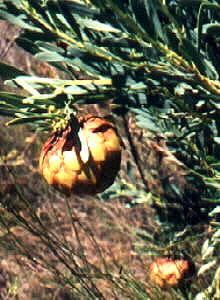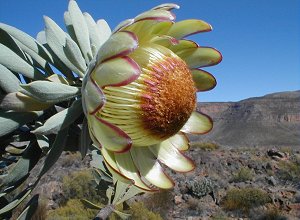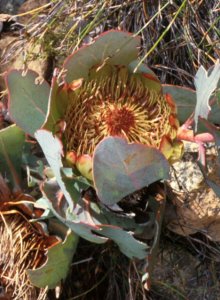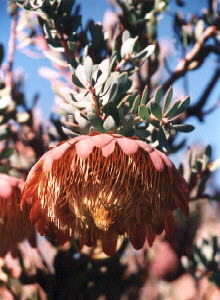|

Home
Mission
Overview of Project
Project Staff
Sponsors
Achievements
Checking, Illustrations
Upcoming Activities
Id and Species Lists
Protea Information
Protea Gallery
Growing Proteas
Interim Dist. Maps
Publications
Afrikaanse Inligting
SANBI
|
|

Penduline Sugarbushes - Proteas
| Kamiesberg Sugarbush - Protea namaquana |
|
 |
Habit: An erect shrub up
to 2m tall
Fire survival: Killed, only seeds survive
Sexual system: Both sexes in each flower
Flowers: June - September
Pollinator: Birds
Fruit: Retained for a few years
Seed dispersal: Wind
Seed storage: In seedheads on plant
Rarity status: Rare, a handful of populations of a few dozen plants occur
Habitat: Upper granite slopes, 1200-1600m
Distribution: Kamiesberg |
| Arid Sugarbush - Protea pendula |
|
 |
Habit: An erect shrub up
to 3m tall
Fire survival: Killed, only seeds survive
Sexual system: Both sexes in each flower
Flowers: May - August, mainly May - June.
Pollinator: Birds
Fruit: Retained for a few years
Seed dispersal: Wind
Seed storage: In seedheads on plant
Rarity status: Usually scattered, isolated populations
Habitat: Arid, rocky areas and kranses, 1000-2000m
Distribution: Cederberg to Kouebokkeveld |
| Hidden Sugarbush - Protea recondita |
|
 |
Habit: An sprawling shrub
up to 3m across and 1m tall
Fire survival: Killed, only seeds survive
Sexual system: Both sexes in each flower
Flowers: May - September, mainly May - July
Pollinator: Birds
Fruit: Retained for a few years
Seed dispersal: Wind
Seed storage: In seedheads on plant
Rarity status: Rare, scattered plants in rocky habitats but in open
habitat isolated clumps of dense plants may dominate vegetation
Habitat: Uppermost rocky slopes, 1000-2000m
Distribution: Piketberg and Cederberg to Grootwinterhoek Mountains |
| Sulphur Sugarbush - Protea sulphurea |
|
 |
Habit: A low dense shrub
up to 0.5m tall
Fire survival: Killed, only seeds survive
Sexual system: Both sexes in each flower
Flowers: April - August
Pollinator: Birds
Fruit: Retained for a few years
Seed dispersal: Wind
Seed storage: In seedheads on plant
Rarity status: Not threatened
Habitat: Dry, arid sandstone soils, 1000-1550m
Distribution: Hex River Mountains to Swartberg and Waboomsberg |
Back Sugarbush Gallery
|

![]()



